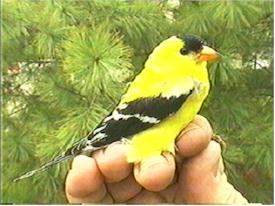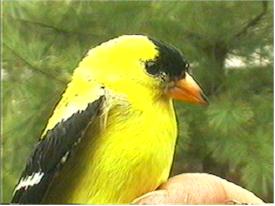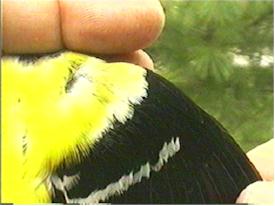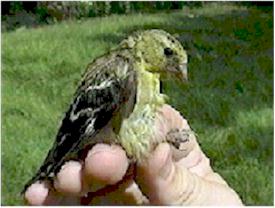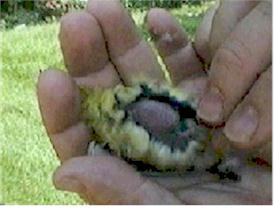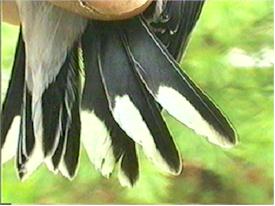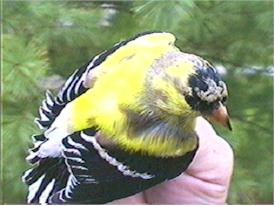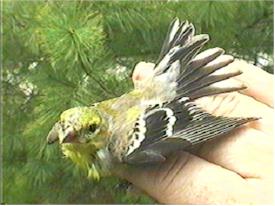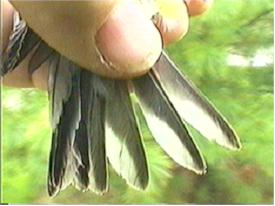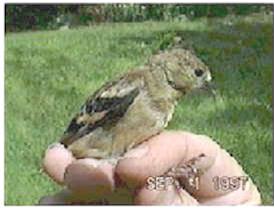American Goldfinch
(Carduelis tristis)
The American Goldfinch, or wild canary, is a delightful visitor to backyards where thistle seed is offered. They are abundant over most of North America where there is suitable habitat, except in the Cascade and Sierra Nevada Mountains. They are one of the world’s 140 or so species of Cardueline finches (family Fringillidae) that include the House Finch, Pine Siskin, Lesser Goldfinch, Lawrence’s Goldfinch, Common Redpoll and Hoary Redpoll, and in Europe the Greenfinch, European Goldfinch, Twite and Linnet.
For centuries, the bright colors and cheery songs of the world’s finches have made them popular cage birds.
Frank Chapman (1902) in his Handbook wrote of the Goldfinch; “Their flight is expressive of their joyous nature, and as they bound through the air they hum a gay ‘per-chic-o-ree.’ Their love song is delivered with an ecstasy and abandon which carries them off their feet, and they circle over the fields sowing the air with music.”
The male in breeding plumage is bright lemon yellow with black wings, tail and a black cap. These finches are 4.5 to 5.5 inches long with a wingspan of 8.75 to 9 inches. Weights range from 12 to a little more than 14 grams.
Figure 1 - American Goldfinch male
Figure 2 - American Goldfinch maleThe slender beak is especially adapted to extract seeds from the seed head of plants such as the thistle, birch, alder, cedar and elm. The intense yellow plumage of the male is produced by carotenoid pigments such as leutin, zeoxanthin, and beta-carotene derived from plant materials in the bird’s diet. It is important that these pigments be available in the spring diet when the birds are replacing their contour feathers.
The upper wing coverts of the adult male are jet black. The shoulder is bright lemon yellow. The black color of feathers, especially wing feathers, is from the pigment eumelanin (Proctor and Lynch 1993).
Figure 3 -Goldfinch male upper wing
Figure 4 - Female
The female is more drab than the male, and her plumage will blend in better with the surroundings when she is on the nest.
When incubating eggs, the female will develop a brood patch on her belly to efficiently transfer heat to the eggs.
Figure 5 - Female Brood Patch
Figure 6 - American Goldfinch male rectrices
There is a significant age and sex difference in the pattern of white on the tail feathers of the American Goldfinch. Mature adult males have extensive bright white patches on their tail feathers. The white on females and younger males is less extensive and more drab. This characteristic is helpful to determine the age and sex of birds in the hand (Pyle 2001).
This male in early spring is still molting into his summer plumage. Grayish feathers on the neck and forehead will be replaced by bright yellow and jet black respectively. In the Cardueline finches, this spring molt is unique to the American Goldfinch (Middleton 1993). In the fall, males loose their bright yellow plumage and become drab like the female. Some observers, unfamiliar with this change to a winter wardrobe, might conclude that the males have migrated out of the area leaving only the females for the winter.
Figure 7 - Male molting into breeding plumage
Figure 8 - Young male
The young males in their second year get some of the yellow coat of feathers, but will not turn bright yellow until their second summer.
Note the less extensive white on the tail feathers of the young male. The tapered (pointed) shape of the outer tail feathers also indicates a younger bird (Pyle 2001).
Figure 9 - Young Male rectrices
Figure 10 - Juvenile in fall
Juvenile birds in the fall have the most drab of all Goldfinch plumages. Note also the dark bill and dusky wing stripes.
Nesting Behavior
The American Goldfinch is one of the latest breeders of all temperate zone passerines (Middleton 1993). Nesting begins in April in the southwestern USA, but birds in the east delay breeding until July. Nesting seems to depend on the flowering of the thistle plant.
A nest of plant fibers and plant down, built by the female, is located in a tree or shrub from 2 to 30 feet high. The nest is woven so tightly that it will hold water, and there have been reports of young birds that have drowned in water retained in the nest following a rain storm when the parents did not protect the nest (Terres 1995).
From 4 to 6 eggs, incubated by the female, hatch in about two weeks. Both parents feed the young regurgitated seeds. Young birds leave the nest by 17 days. Up to three broods may be raised in a breeding season (Baicich and Harrison 1997).
Banding Recoveries
According to the web page of the Bird Banding Lab, a total of 1,028,702 American Goldfinches were banded between 1955 and 2000. Banding studies show that flocks tend to move together. Some populations are migratory, and there is regional movement in wintering populations. One individual banded in Ontario in March was recovered 8 months later in Louisiana, a distance of 976 miles (Middleton 1993).
If you should recover a banded bird, you can report the band number to the Bird Banding Lab by calling 1-800-327-BAND.Economic Importance and Conservation Status
Clearing of forests and creation of open weedy areas has benefited the American Goldfinch. American Goldfinches are almost exclusively grainivorous, even when feeding young. They provide an important service by consuming large numbers of weed seeds. The increase in backyard feeding has also benefited this species.
Flocks of Goldfinches are somewhat nomadic, and will move around to locate better food resources. Flocks will move up to 5 miles per day between feeders (Middleton 1993).
If the flock visiting your backyard suddenly disappears, they have moved on to another area, and will soon be replaced by another flock. Check your seed to make sure it is fresh and clean. Keep you feeders clean as well. Soiled feeders, especially thistle feeders where birds must use the same perches and openings to grasp the seeds, can transmit diseases between birds.
